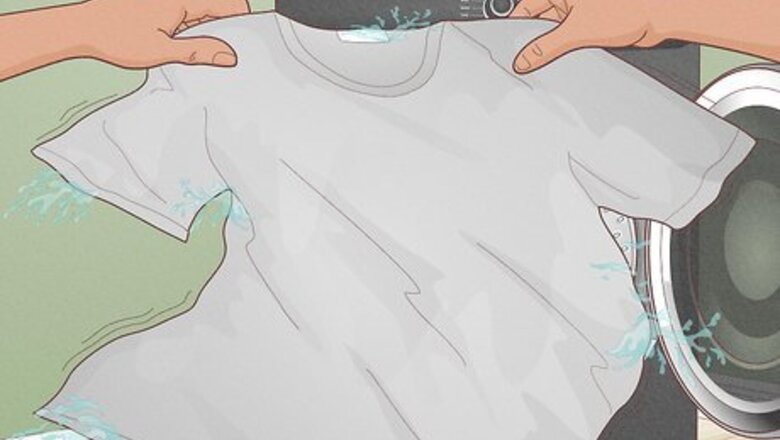
views
- Pin the largest, heaviest items to the clothesline first to save space. Fold blankets and sheets in half and pin the folded half to the clothesline.
- Then, clip pants and jeans by the cuffs. Pin shirts to the clothesline where the side seam meets the bottom hem.
- Dry clothes indoors by folding your garments in half over the bars of a drying rack or over a shower or curtain rod.
Using a Clothesline Outside
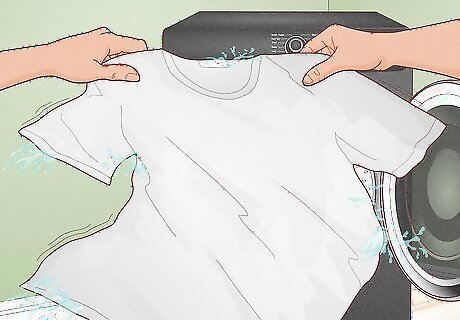
Shake out each garment after removing it from the wash. Giving your clothes a good shake before you hang them up helps eliminate wrinkles and soften your items as they dry. Just hold your garment by the flattest end and give it 1 to 2 quick shakes. Hang up your clothes as soon as your machine finishes washing them. Leaving clothes in the washer can create wrinkles and leave them smelling musty.
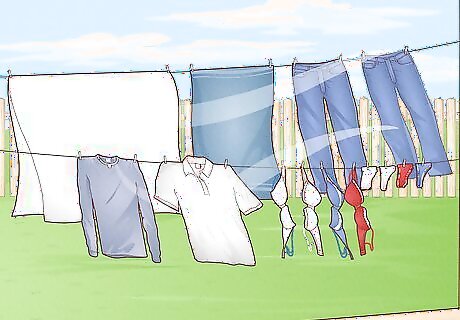
Group similar garments together and hang the biggest items first. When you take out your laundry, sort your items from largest to smallest. So, put your linens, towels, pants, shirts, socks, and undergarments together. Then, hang up your biggest items first to make sure they have enough space to dry.
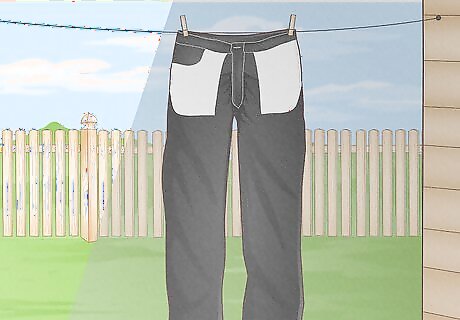
Hang dark clothes inside out and out of direct light to prevent fading. Sunlight can fade dark or bright-colored garments, so turning them inside out helps slow down the process. Just take a moment to turn any jeans, pants, shirts, dresses, or skirts inside out. Then, hang these items out of direct sunlight to prevent any potential bleaching. Feel free to leave white clothing out in the direct sun. The sun’s rays naturally bleach and brighten light-colored garments.
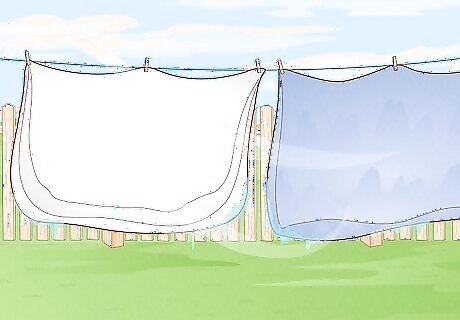
Fold sheets and blankets in half and hang them by the folded end. Take your blanket or flat or fitted sheet and fold it in half lengthwise. Then, bring the folded end up to the clothesline so the crease faces the ground. Pin the corner with a clothespin and stretch the fabric taut as you move across the line to pin the middle and the other corner. The folded crease is the heaviest part of the blanket or sheets, so keeping it face down allows it to get more airflow and dry quicker. Keeping the top of the sheet flat and straight helps prevent wrinkles. Put down blankets or comforters in the dryer instead of air drying them. The down might clump together and not dry properly when it’s hung.
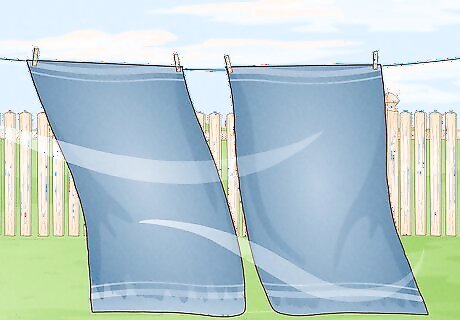
Keep towels unfolded and vertical on the clothesline. Bring your towels up to the clothesline so one of the short ends faces the line. Then, drape it slightly over the clothesline and pin both corners in place. To save space and clothespins, hang your towels next to each other and clip the corners together with the same pin. If your towels or garments feel stiff after drying, hang them where they catch a good breeze. Then, add fabric softener to your wash cycle or make your own softener with vinegar. Alternatively, place your items in the dryer for 5 to 10 minutes while they’re slightly damp to soften and fluff them.
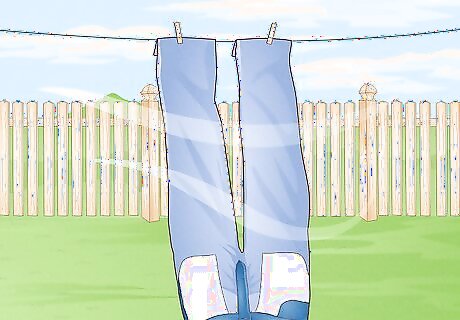
Pin pants and jeans to the clothesline by the leg cuffs. The heaviest part of your pants is the waist, so allowing the waist to hang gives it more airflow and helps your pants dry faster. Simply hold the bottom of your pants against the clothesline. Then, pin each pant leg cuff in place. If you have 2 clotheslines side by side, separate the legs and pin 1 to each line to help speed up the drying time.

Clip shirts at the side seams and hang them by the bottom hem. Hanging your t-shirts and blouses by the sides and hem prevents creases and helps them dry faster. Just turn your shirt upside down and place a clothespin where the side seam and bottom hem meet. Then, pull the bottom taut and clip the other corner. Pulling the hem straight and flat ensures the shirt doesn’t sag on itself and creates wrinkles. Alternatively, hang non-stretchy shirts on a hanger and hook the hanger on your clothesline. Don't hang stretchy fabrics and heavy knits, like sweaters. Hanging them up can make them lose their shape or stretch out, so lay them flat to dry.

Hang socks in pairs by the toes. To save space and avoid misplacing your socks, keep your pairs pinned together. Overlap your pair of socks slightly and curl the toes over the clothesline. Then, place a single clothespin between the socks to fasten both in place.
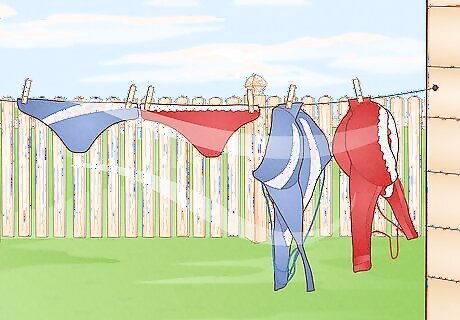
Fasten undergarments by the waist or at the corners. Hold undergarments like underwear and boxers up to the clothesline by the waist. Then, stretch them out on the line so they don’t sag, and clamp a clothespin on each corner. If you’re drying bras, reshape any padding inside the cups and then drape them over the line. If you’re short on space, look for spots between your other garments. Don’t hang bras on the line by the straps, as that can stretch them out.
Hanging Clothes to Dry Indoors

Dry your clothes in a well-ventilated space with low humidity. When you dry your clothes inside, you need a lot of dry, circulating air to remove moisture and keep them smelling fresh. Choose an open space in your home that’s near a window, fan, or vent to give your garments more airflow. Then, make sure the space doesn’t trap humidity; basements and attics tend to stay stuffy and moist. For extra air circulation, set a standing fan by your clothes to speed up drying. If you live in a humid area, place a dehumidifier near your clothes to remove moisture faster. Do not place your clothing directly onto a heat source, like a heating vent. The heat can potentially start a fire. The area you choose doesn’t have to get direct sunlight—just placing your clothes in an open, well-ventilated area helps them dry. Plus, direct sunlight can fade blacks and bright colors.
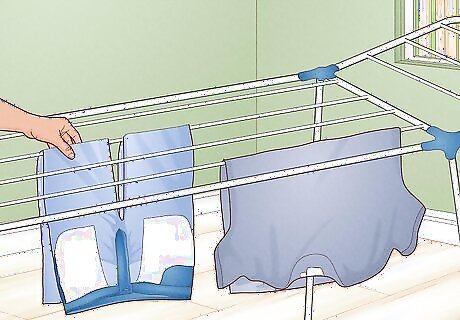
Fold your clothes over a drying rack. If you don’t have space for a clothesline outside, a drying rack is a great alternative. Simply drape your linens, towels, pants, shirts, and undergarments in half over the rack’s bars. Drying racks are especially great because you can easily move them around. If you have space outside, set one up on your patio, balcony, or lawn.

Drape clothing over a wall-mounted rod or a shower, curtain, or closet rod. Wall-mounted rods work similarly to drying racks. Just drape your garments in half over the rod and straighten them out so they’re free from wrinkles. Or, fold them over a shower, curtain, or closet rod. To keep the space under your clothes dry, set towels or buckets underneath them to collect any dripping water.
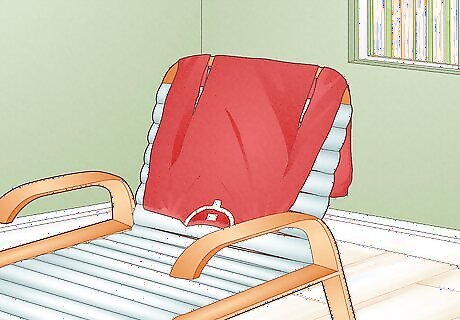
Use doors, chairs, and other household items to dry your clothes. If you don’t have a drying rack or wall-mounted rod, turn pieces of furniture into a DIY drying rack. For example, fold your clothes over the top of your doors or the backs of your chairs. Or, hang clothes off of a coat rack or the blades of a ceiling fan. If you’re drying small items, lay them on an over-the-sink drying rack. As another alternative, tape a string between your door frame to make an indoor clothesline. Then, hang or fold your clothes over it.
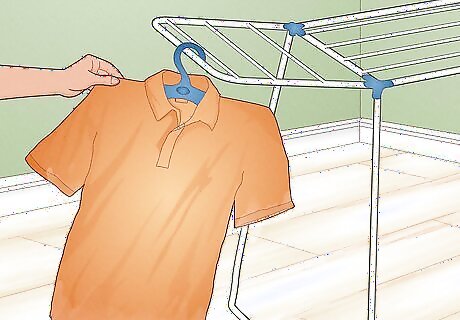
Hang non-stretchy items on hangers and hook them on a rack or rod. To speed up the drying process for non-stretchy shirts, pants, and dresses, simply slip them onto hangers. Then, hook the hanger onto the bars of your drying rack. Or, hang them from your shower or curtain rod. Use plastic hangers when you hang damp items. Wooden and velvet hangers can absorb moisture that encourages mold and mildew to grow. Hangers can sometimes leave indents or imprints on shirt shoulders when you leave them to dry.
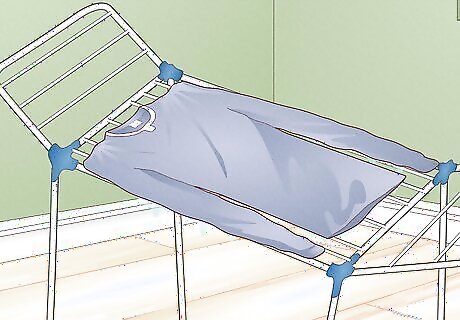
Lay heavy, stretchy, and delicate garments flat. Clothing items like knit sweaters, wool garments, and silky lingerie can stretch out when they’re hung up to dry. Instead, lay these items flat across the bars of your drying rack. Or, lay down a dry towel on your counter and place the garments on top. As another alternative, lay your garments flat inside a drying net. Simply hook the net onto a wall-mounted rod, like one in your closet or shower.
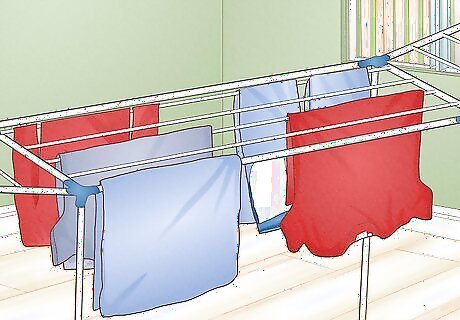
Leave ample space between each garment to help them dry. Stacking or overlapping your clothes on a drying rack or rod reduces air circulation and slows down the drying process. Instead, spread apart your clothes as much as possible, leaving about 1 to 2 inches (2.5-5 cm) between each item.
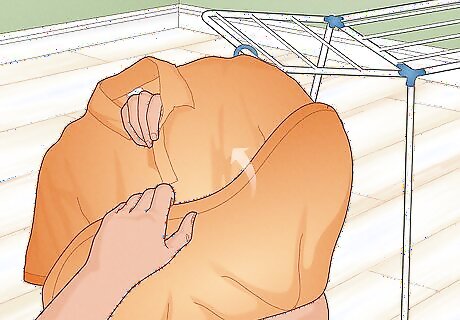
Flip over your clothes about halfway through drying. It typically takes several hours to completely dry your clothes, though that depends on their size and material. After about 1 to 2 hours, feel your clothes. If they’re damp but not overly wet, flip them over. This lets the other side breathe and dry, which speeds up the process and helps prevent musty odors. Larger, heavier items like blankets, towels, and jeans might take a day to fully dry.
Benefits of Hanging Clothes to Dry
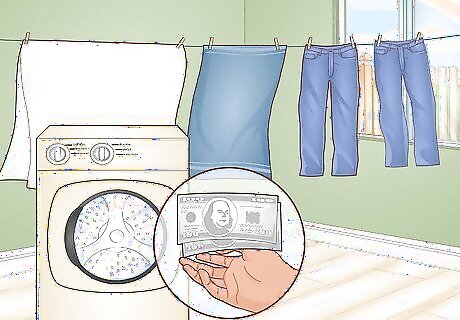
Hang-drying your clothes saves energy and money. Your dryer accounts for about 6% of your energy usage, which can rack up a large bill at the end of each month. Dryers are also one of the least energy-efficient appliances in your home. So, air-drying your clothes is a more cost-effective and sustainable option. For example, if everyone in the US switched to energy-efficient dryers and used them less often, they would prevent nearly 16 million tons of carbon dioxide from being emitted into the atmosphere each year.

Air drying reduces the wear and tear on your clothes. Your clothes rub and chafe together as they tumble dry in your dryer, which can lead to stretching, tears, snags, and pilling. The high heat from your dryer can also cause your clothes to prematurely fade.
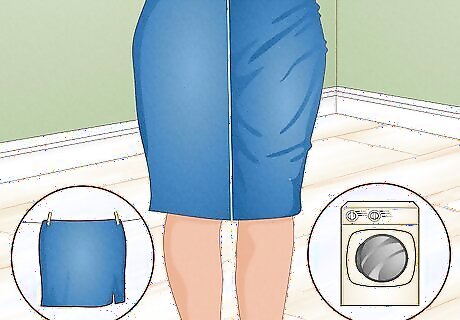
Leaving your clothes to hang dry prevents static cling. When you dry your clothes in a dryer, your garments rub together and create static electricity. This can cause them to stick to themselves and drape unnaturally when you wear them. Instead, the gentle breeze from outside dries each garment individually which prevents static cling.

Drying your clothes outdoors gives them a fresh, clean scent. You don’t have to use fancy dryer sheets or balls to get your clothes to smell nice. The outdoor breeze leaves your clothes with a crisp, light fragrance that doesn’t cost you a cent.



















Comments
0 comment